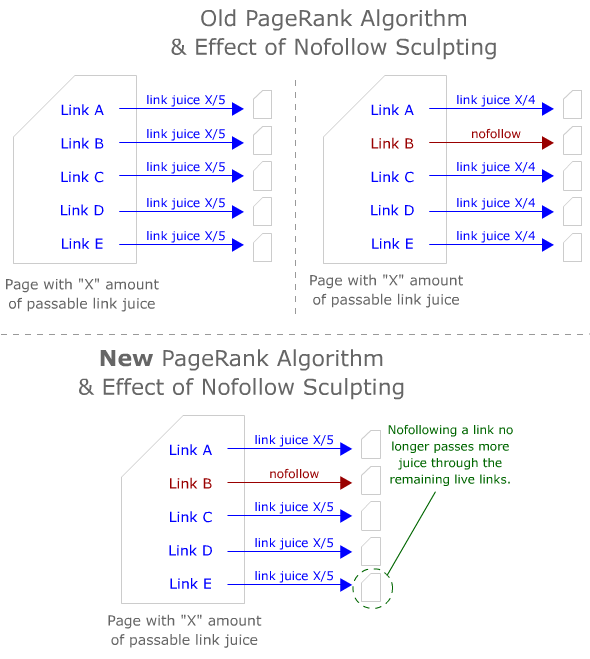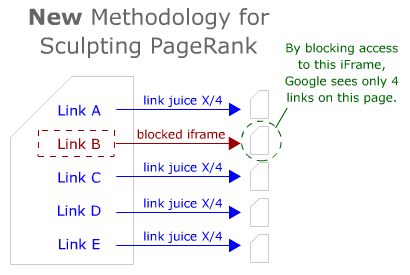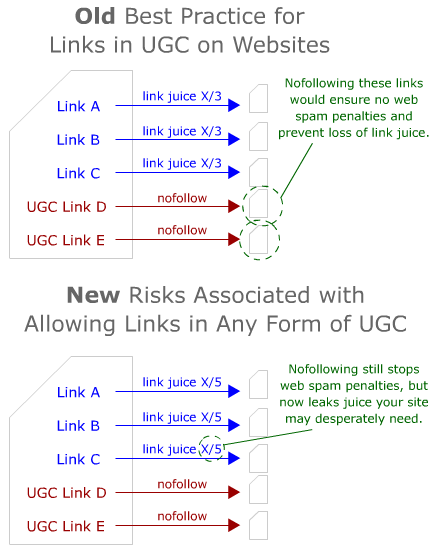
Google Says: Yes, You Can Still Sculpt PageRank. No You Can't Do It With Nofollow
The author's views are entirely their own (excluding the unlikely event of hypnosis) and may not always reflect the views of Moz.
The blog post - PageRank Sculpting - from the head Google's Web Spam team is a critical read for SEOs worldwide:
So what happens when you have a page with “ten PageRank points” and ten outgoing links, and five of those links are nofollowed? Let’s leave aside the decay factor to focus on the core part of the question. Originally, the five links without nofollow would have flowed two points of PageRank each (in essence, the nofollowed links didn’t count toward the denominator when dividing PageRank by the outdegree of the page). More than a year ago, Google changed how the PageRank flows so that the five links without nofollow would flow one point of PageRank each.
It's valuable to recall the illustration I put up on Google's initial announcement of this change:

This change in Google's treatment of nofollow links comes with some very interesting additional advice/clarification:
Q: Okay, but doesn’t this encourage me to link out less? Should I turn off comments on my blog?
A: I wouldn’t recommend closing comments in an attempt to “hoard” your PageRank. In the same way that Google trusts sites less when they link to spammy sites or bad neighborhoods, parts of our system encourage links to good sites.
Many in the SEO field have long suspected that linking out to good places can provide a positive benefit, but I'm afraid that's going to be very hard to quantify and therefore difficult to justify. In all honesty, I believe we're going to see SEOs and websites revert to what I'll call "old-school" PageRank sculpting - the kind prevalent prior to the existence of nofollow.
From now on, if you wish to sculpt PageRank, you'll want to use one of the following classic PR sculpting methodologies:
- Option A: An embedded iFrame on the page containing the links you don't want the engines to follow (remember not to link to the iFrame URL, and potentially block it using robots.txt)
- Option B: Links that call a Javascript redirect script with access blocked for search engine bots (as Google is also now crawling basic javascript and counting links through it)
- Option C: An embed in Flash, Java or some other non-parseable plug-in that contains the desired links
- Option D: Settings that turn off links for non-cookied or non-logged-in visitors

Tragically, while this action won't hurt spammers or those seeking to manipulate Google, it will seriously harm many thousands of sites that have employed nofollow internally as it was long considered a best practice (and messaged as such to the SEO community by the same source as this reversal). I suspect it will be several years and many re-designs before a lot of sites are able to clean up this solution-turned-problem.
I'm saddened to say that given this change, we, as SEOs, are going to have to also recommend the best practice that comments (in all forms of UGC) no longer accept links. While Google has said that linking out to "good places" provides some value, that merely suggests that webmasters and site owners should select good resources editorially and link to them with live, followed links. Comments that contain links, unfortunately, will actively detract from a site's ability to get pages indexed (as they'll pull away link juice from the places that need it). It's likely that a plug-in for Wordpress that sends comment links out through uncrawlable Javascript or uses iFrames will emerge in the very near future.

This is a disappointing move from Google on many fronts:
- It allows malicious operators to actively hurt a site by adding nofollowed links in comments, forums and other open submission arenas.
- It removes the protection webmasters thought was afforded by nofollowing links (you may not get hurt for linking to spam or paid links directly, but you're now indirectly hurting your site's PageRank flow)
- It casts doubt on Google's credibility with future messaging to webmasters (Danny Sullivan covered this when he wrote about the loss of backwards compatibility)
While I'm personally frustrated, I'm also thankful to Google for publicly messaging this in an honest, open way. I hope that in the future, we'll get this notification in a more timely fashion. SEO consultants and in-house analysts are going to have their work cut out for them over the next few months.
BTW - Although Google has almost certainly messaged this honestly, we've got some tests running to make sure this is the case (with both the nofollow and the iframe/javascript solutions). Results will be posted here once our tests have been confirmed. We're also going to be making changes to how Linkscape's mozRank scoring system, modeled around similar intuition as PageRank, will treat nofollowed links in future indices.
p.s. Danny Sullivan's comment on Matt's blog post is also an essential read (and re-iterates many of the points above). A few valuable excerpts:
With this change, I can still get the $4 if I simply don’t allow comments. Or I show comments, but I use an iframe, so that the comment actually reside on a different page. In either case, I’m encouraged to reduce the number of links rather than let them be on the page period, nofollow regardless. If I’m worried my page won’t seem “natural” enough to Google without them, maybe I allow 5 comments through and lock them down after that.
Rather than clarify things, I feel like this is what your post is going to do -- cause people to consciously reduce the number of links they allow on their pages. We’re going to see an increase in iframe usage or other techniques to reduce links and flow more PageRank to the remaining links, for those who really worry/believe in such things.
It's been a long time since we had such a fundamental shift in SEO best practices (maybe the canonical URL tag, though it's effectiveness has been questioned and this PR sculpting reversal isn't likely to inspire confidence).



![How to Optimize for Google's Featured Snippets [Updated for 2024]](https://mza.bundledseo.com/images/blog/banners/599c98d541a541.28015161_2021-03-30-231401.jpg?w=580&h=196&auto=compress%2Cformat&fit=crop&dm=1617146041&s=bcfded4bdc1de1792b6efcfd16b9152f)
Comments
Please keep your comments TAGFEE by following the community etiquette
Comments are closed. Got a burning question? Head to our Q&A section to start a new conversation.